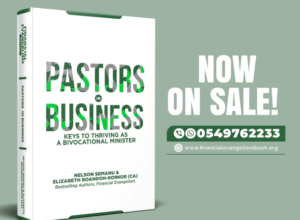By Nelson Semanu BOANDOH-KORKOR & Elizabeth BOANDOH-KORKOR
“.…served churches as the people moved west, supporting themselves as farmers, store owners, schoolteachers, and many other occupations while also providing pastoral care to their congregations and leading worship on Sunday mornings.” ~Dennis Bickers, Author, “The Bivocational Pastor: Two Jobs, One Ministry”.
“Bi-vocational ministry is not inherently wrong; it is a practical and sometimes necessary approach. It requires hard work, careful scheduling, and prioritization. Churches with bi-vocational pastors should offer grace, support, and consider transitioning them into full-time employment as the church grows and resources allow.”
Last week, we introduced the concept of bivocational ministry. This week, we’ll delve deeper into this topic, exploring additional evidence and insights to support the practice of bivocational ministry.
Some may argue against bi-vocational ministry, citing the early church’s example in Acts 6:2-4, where the apostles delegated tasks to focus on prayer and teaching. However, this doesn’t necessarily prohibit bi-vocational ministry; it emphasises prioritising core ministerial functions.
In fact, the Apostle Paul himself engaged in bi-vocational ministry as a tentmaker, supporting himself and his companions while spreading the Gospel in Corinth and Ephesus (Acts 18:3; 20:34). This model mirrors the situation of many bi-vocational pastors today.
While pastors should prioritise preaching (2 Timothy 4:2), bi-vocational pastors can maintain this focus while working a second job. Balancing both roles requires strong time management and support from church members.
Bi-vocational ministry offers unique advantages. Pastors engage with the community through their secular work, creating opportunities for outreach and modelling a Christian life in the workplace. This can lead to new connections and a deeper understanding of the needs and challenges faced by people outside the church.
Bi-vocational ministry is not inherently wrong; it’s a practical and sometimes necessary approach. It requires hard work, careful scheduling, and prioritisation. Churches with bi-vocational pastors should offer grace, support and consider transitioning them into full-time employment as the church grows and resources allow.
Bi-vocational ministry is a valid and valuable option, especially for smaller or financially constrained churches. It allows pastors to fulfil their calling while maintaining financial stability and provides unique opportunities for outreach and ministry in various settings.

The evolution of bi-vocational ministry
Bi-vocational ministry is experiencing a resurgence today. Driven by missional theology, incarnational ministry, the theology of work and the realities of post-Christendom, conferences and cohorts are equipping pastors for this dual-role ministry. However, it is important to state that bi-vocational pastors and missionaries are not a new phenomenon.
Incarnational ministry is a theological approach emphasising the importance of immersing oneself in a particular community or culture to share the gospel and demonstrate Christ’s love through personal relationships and service.
It draws inspiration from the incarnation, where Jesus Christ, the Son of God, took on human form to dwell among us. Thus, incarnational ministry seeks to follow Christ’s example by entering into the lives of others, understanding their context and meeting them where they are.
Dual-role ministry, or tent-making, as a means for Christian leaders to finance their mission has been practised since the early Church. Throughout history, the full-time, fully-funded pastor has been the exception, while bi-vocational ministry has been the norm. Moreover, bi-vocational ministry is not rare today; most pastors around the world earn their living from means other than serving their churches.
Author Dr. David M. Gustafson, in his insightful article ‘A Church History of Bivocational Ministry: Tentmaking from the Beginning till Now’, identifies four evolutionary stages of bivocational ministry. We will adapt these stages for our discussion.
Stage 1: It started with Jesus’ apostles
Bi-vocational ministry was common in the early church. Jesus’ apostles were commercial fishermen before following Him, returning to this livelihood after His crucifixion and before their mission to preach the Gospel (John 21:1–25).
The Apostle Paul, a prominent figure in early Christianity, also practised bi-vocational ministry (1 Corinthians 4:12). Unlike Peter and other apostles supported by church collections, Paul made tents (Acts 4:34–37; 18:1–3). This led to the term “tentmaking” for dual-role pastors, missionaries and church planters who have other employment.
Paul didn’t want to burden the churches he founded financially (1 Thessalonians 2:7–9; 2 Thessalonians 3:6–8). He hoped his work would build credibility among non-Christians, providing opportunities for evangelism (1 Corinthians 9:19; 2 Corinthians 11:7). When sent as a missionary with Barnabas, they travelled at their own expense (Acts 13:1–3; 20:33–35; 1 Corinthians 9:15–18).
This practice demonstrates the resourcefulness and dedication of early Christian leaders, who prioritised spreading the Gospel while maintaining self-sufficiency through their secular work.
Stage 2: From Zeno to Spyridon
Paul’s bi-vocational practice continued as the norm during the early church’s formation throughout the Roman Empire. In the first three centuries, apostles, prophets, evangelists and pastors commonly held secular jobs alongside their ministry.
Tertullian (160–220) advocated for this, stating: “Let the young persons of the Church endeavour to minister diligently… so that you will always have sufficient funds to support both yourselves and those that are needy, and not burden the Church of God. For we ourselves, besides our attention to the word of the Gospel, do not neglect our inferior employments. For some of us are fishermen, tentmakers and farmers, so that we may never be idle“.
Examples of bi-vocational ministry abound in the early church:
- Spyridon of Cyrus (ca. 270–348), bishop and shepherd.
- I Basil of Cappadocia (330–379), whose priests worked for their livelihood.
- Chrysostom (ca. 347–407), who spoke of rural pastors ploughing fields.
- Zeno (d. ca. 400), bishop and linen weaver.
However, a shift occurred in the fourth century with the rise of Christendom. The church’s alignment with the Roman state led to fully-funded positions for bishops and pastors in established urban congregations. This fostered a class of professional clergy trained in theology, marking a departure from the earlier bi-vocational model.
Stage 3: Widening of the clergy/laity divide
During Christendom, the divide between clergy and laity widened. Augustine of Hippo (354-430), for instance, prioritised the contemplative life over the active life, although he acknowledged the value of work. This view, emphasising a “religious” or “sacred” vocation for those in contemplation, soon dominated Christian thought.
Monastic communities were established for those devoted to prayer and the contemplative life. However, some monastic rules, like those of Pachomius of Egypt (ca. 292–348) and Benedict of Nursia (480–547), incorporated work alongside prayer and study.
The Benedictine Monastic Movement in Europe became a significant missionary and church-planting force in the medieval period. Martin Luther (1483–1546), the Reformer, challenged this division by asserting that all of life, including work, is a calling from God. Lutherans believed that fulfilling everyday work duties was a way to serve God and love one’s neighbour. This teaching challenged the clergy-laity divide and shaped views on vocation and work.
Count Nicholas von Zinzendorf (1700–1760) of the Moravian Brethren inspired missionary activity. Learning about the needs in the West Indies, he sent Leonhard Dober (a potter) and David Nitschmann (a carpenter) as self-supporting missionaries. Zinzendorf encouraged and regulated self-support among missionaries, aligning with the earlier model of bi-vocational ministry.
However, bi-vocational ministry faced challenges. Moravian missionaries in Labrador, Canada, established a trade store for the welfare of the Eskimos. Yet, they found it difficult to balance their dual roles as ministers and merchants, facing conflicts between their spiritual and commercial obligations.
Stage 4: Bivocational ministries today
In America, bi-vocational pastors emerged out of necessity when new congregations did not have resources to support them. Even when churches had resources, some preferred bi-vocational ministry. For example, colonial ministers of the Church of England in the 1600s maintained themselves by means of the parson’s glebe, a piece of land set aside for the pastor’s use to support himself.
Moreover, many Southern Baptist congregations were led by a farmer-preacher who tilled ground, split rails, planted corn, fed hogs, preached sermons, performed weddings and conducted funerals.
Furthermore, early Evangelical Free Church preachers in America were mostly bi-vocational. At the 1884 Boone Conference that was called to discuss theological questions regarding the nature and practice of the church, the 22 who attended were mostly itinerant evangelists and lay preachers who served one or more newly established congregations.
It may be time to rethink the “professional ministry model” of Christendom.
Twenty years later, however, one church after another was calling a resident pastor. This caused tension between two schools of thought: E. A. Halleen, former president of the Swedish Evangelical Free Church who went on to become the first president of the EFCA, favoured resident pastors; August Davis, an early pastor in the Swedish Evangelical Free Church, preferred itinerant preachers who travelled for a few months of the year to minister to the congregations. During the rest of the year, the itinerant preachers earned a living from farming or their trade.
As local churches became more established, resident pastors became the common practice.
Throughout church history, God has led His people to carry out His mission in the world through pastors and missionaries who have supported themselves, as well as through those who were supported by churches. From the beginning, tent-making missionaries like Paul’s emerged, serving both voluntarily and out of necessity. Where Christianity was established and local churches received adequate funding—generally in cities, fully-funded pastors became the norm.
Today, however, as the West becomes increasingly post-Christian, bi-vocational ministry is again a viable means to proclaim the gospel, offering it free of charge (1 Corinthians 9:18). It may be time to rethink the “professional ministry model” of Christendom and again consider the validity of bi-vocational ministry. It has not merely a biblical basis but a long history.
For further study on this subject, kindly get a copy of our book: Pastors In Business: Thriving As A Bivocational Minister; Strategic Keys To Success.
Nelson Semanu Boandoh-Korkor is a distinguished figure, acclaimed as an Author, Publishing Consultant, Christian Business Coach, and a fervent Financial Evangelist. Nelson is a forex trader, cryptocurrency investor and metaverse enthusiast.
Elizabeth Boandoh-Korkor (CA) is an accomplished Chartered Accountant with extensive experience as a Financial Management Consultant, spanning close to two decades in both the not-for-profit and banking sectors. You can reach out to them on +233549762233 or [email protected]










